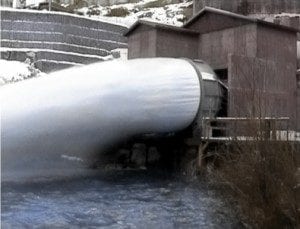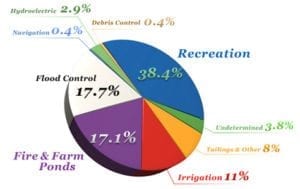Dams are built for a number of uses in addition to producing electricity – in fact, only 3 percent of the nation’s 80,000 dams currently generate power. From flood control to recreational activities, dams can help protect, support and improve communities.
Recreation
 Swimming, boating, fishing, camping, skiing, and hiking are just some of the recreational activities that take place year-round and across the country at sites developed and supported by the hydropower industry. Dam operators work with local communities to allow for recreational access. For example, dam operators can schedule water releases so that whitewater rafters can hone their skills on tailwaters – fast moving water located immediately downstream from the dam. In just one of many examples, utility PacifiCorp operates 15 recreational facilities along the Lewis River below the Merwin Dam in Washington State. Along the river and shores of three reservoirs, the utility offers the public 304 campsites in four campgrounds, 270 picnic sites and nine boat launch locations.
Swimming, boating, fishing, camping, skiing, and hiking are just some of the recreational activities that take place year-round and across the country at sites developed and supported by the hydropower industry. Dam operators work with local communities to allow for recreational access. For example, dam operators can schedule water releases so that whitewater rafters can hone their skills on tailwaters – fast moving water located immediately downstream from the dam. In just one of many examples, utility PacifiCorp operates 15 recreational facilities along the Lewis River below the Merwin Dam in Washington State. Along the river and shores of three reservoirs, the utility offers the public 304 campsites in four campgrounds, 270 picnic sites and nine boat launch locations.
Dam Safety and Security
 The Federal Energy Regulatory Commission (FERC) is responsible for overseeing the safety of non-federal dams and performs routine inspections to ensure compliance. Dam safety is also ensured through a partnership of states, federal agencies and other stakeholders known as the National Dam Safety Program. Headed by the Federal Emergency Management System, the program provides training for dam safety staff and inspectors, issues grants to state dam safety programs and conducts safety research.
The Federal Energy Regulatory Commission (FERC) is responsible for overseeing the safety of non-federal dams and performs routine inspections to ensure compliance. Dam safety is also ensured through a partnership of states, federal agencies and other stakeholders known as the National Dam Safety Program. Headed by the Federal Emergency Management System, the program provides training for dam safety staff and inspectors, issues grants to state dam safety programs and conducts safety research.
The National Dam Safety Program: 25 Years of Excellence
Flood Control
Dams have an important role to play in preventing the loss of life or property due to flooding. Flood control dams capture floodwaters and can then release them under controlled circumstances to the river below, or the water can be stored and utilized to meet other needs, not only avoiding potential disaster but turning the event into a future benefit. In a flood situation, federal and non-federal dam operators work together to manage water levels along rivers and other waterways, coordination that saves property and lives.
Flood Control at the Blackwater Dam in Webster, New Hampshire
The US Army Corps of Engineers, which carries out flood control infrastructure projects, operates facilities like the Blackwater Dam.
USES OF DAMS

The USACE describes the dam system: “The principal objective of the dam and reservoir is to protect downstream communities. It is part of a network of five flood control dams in the Merrimack River Basin. These dams work together to control flood waters during heavy rains and storms until rivers begin to drop and the stored water can be slowly and safely released. Located approximately 8.6 miles above the confluence of the Blackwater and Contoocook Rivers, Blackwater Dam helps protect cities and towns from Concord, Manchester, and Nashua, New Hampshire to Lowell, Lawrence, and Haverhill, Massachusetts. Blackwater Dam was completed in 1941 at a cost of $1.32 million and has already prevented $15.3 million in damages. The reservoir has a storage capacity of 15 billion gallons of water. To date, record high water occurred during the flood of April 1987.The reservoir was filled to 93% capacity with a water level of 564.1 mean sea level (msl). The normal level is 518 msl.”


